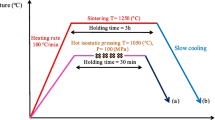Abstract—A spherical titanium powder is fabricated by the plasma atomization of a wire made of commercial-purity VT1-00 titanium. The characteristics of the powder are measured to determine the possibility of using this powder in additive technologies. The morphology, internal structure, chemical composition, and microhardness of the powder particles and the technological characteristics of the powder are investigated.






Similar content being viewed by others
REFERENCES
A. G. Kolmakov et al., “Corrosion-resistant steels in additive manufacturing,” Izv. Vyssh. Uchebn. Zaved., Chern. Metall. 64 (9), 619–650 (2021).
K. Riener et al., “Influence of particle size distribution and morphology on the properties of the powder feedstock as well as of AlSi10Mg parts produced by laser powder bed fusion (LPBF),” Additive Manufact. 34, Article no. 101286 (2020).
A. Mussatto et al., “Influences of powder morphology and spreading parameters on the powder bed topography uniformity in powder bed fusion metal additive manufacturing,” Additive Manufact. 38, Article no. 101807 (2021).
A. B. Spierings, N. Herres, and G. Levy, “Influence of the particle size distribution on surface quality and mechanical properties in AM steel parts,” Rap. Prototyp. J. 17 (3), 195–202 (2011).
B. Liu et al., “Investigation the effect of particle size distribution on processing parameters optimization in selective laser melting process,” in Additive Manufacturing Research Group (Loughborough University, 2011), pp. 227–238.
S. Lagutkin et al., “Atomization process for metal powder,” Mater. Sci. Eng. A 383 (1), 1–6 (2004).
K. Guo et al., “High pressure EIGA preparation and 3D printing capability of Ti–6Al–4V powder,” Trans. Nonf. Metals Soc. China 30 (1), 147–159 (2020).
M. I. Alishin and A.E. Knyazev, “Production of metallic powder compositions of high-purity titanium alloys by induction gas atomization for additive technologies,” Tr. VIAM, No. 11 (59), 35–45 (2017).
M. Akkas, T. Cetin, and M. Boz, “The effect of gas pressure on powder size and morphology in the production of AZ91 powder by gas atomization method,” Arch. Met. Mater. 63, 1587–1594 (2018).
X. Li et al., “Fine spherical powder production during gas atomization of pressurized melts through melt nozzles with a small inner diameter,” Powder Technol. 356, 759–768 (2019).
P. Ding et al., “Preparation, characterization and properties of multicomponent AlCoCrFeNi2.1 powder by gas atomization method,” J. Alloys Compd. 721, 609–614 (2017).
P. Sun et al., “Review of the methods for production of spherical Ti and Ti alloy powder,” JOM 69 (10), 1853–1860 (2017).
T. A. Kalayda et al., “The plasma atomization process for the Ti–Al–V powder production,” J. Phys.: Conf. Series 1942 (1), Article no. 012046 (2021).
A. E. Knyazev, S. V. Nerush, M. I. Alishin, and I. S. Kuko, “Technological properties of metal-powder compositions of titanium alloys VT6 and VT20 fabricated by induction melting and gas atomization,” Tr. VIAM, No. 11, 46–55 (2017).
M. Y. Kharlamov, I. V. Krivtsun, and V. N. Korzhyk, “Dynamic model of the wire dispersion process in plasma-arc spraying,” J. Therm. Spray Technol. 23 (3), 420–430 (2014).
A. N. Krasnov, V. G. Zil’berberg, and Yu. Sh. Semen, Low-Temperature Plasma in Metallurgy (Metallurgiya, Moscow, 1970).
G. Chen et al., “A comparative study of Ti–6Al–4V powders for additive manufacturing by gas atomization, plasma rotating electrode process and plasma atomization,” Powder Technol. 333, 38–46 (2018).
J. Dawes et al., “Introduction to the additive manufacturing powder metallurgy supply Chain,” Johnson Matthey Technol. Rev. 59 (3), 243–256 (2015).
K. K. Guo et al., “High pressure EIGA preparation and 3D printing capability of Ti–6Al–4V powder,” T. Non-ferr. Metal. Soc., No. 30(1), 147–159 (2020).
ACKNOWLEDGMENTS
We thank A.Yu. Ivannikov for useful discussions in planning and conducting the experiments.
Funding
This work was supported by the Russian Science Foundation, project no. 21-79-00259.
Author information
Authors and Affiliations
Corresponding authors
Ethics declarations
The authors declare that they have no conflicts of interest.
Additional information
Translated by K. Shakhlevich
Rights and permissions
About this article
Cite this article
Smirnov, S.A., Kirsankin, A.A. & Kalaida, T.A. Properties of the Spherical Titanium VT1-00 Powder Fabricated by Plasma Atomization of a Wire. Russ. Metall. 2022, 741–745 (2022). https://doi.org/10.1134/S0036029522070126
Received:
Revised:
Accepted:
Published:
Issue Date:
DOI: https://doi.org/10.1134/S0036029522070126




